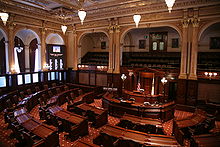
Government of Illinois
Government of Illinois | |
|---|---|
 | |
| Part of | United States of America |
| Constitution | Constitution of Illinois |
| Legislative branch | |
| Name | Legislature |
| Type | Bicameral |
| Meeting place | Illinois General Assembly |
| Upper house | |
| Name | Senate |
| Presiding officer | Don Harmon, President |
| Lower house | |
| Name | House of Representatives |
| Presiding officer | Emanuel Chris Welch, Speaker |
| Executive branch | |
| Head of state and government | |
| Title | Governor |
| Currently | J. B. Pritzker |
| Appointer | Election |
| Cabinet | |
| Name | Cabinet |
| Leader | Governor |
| Deputy leader | Lieutenant Governor |
| Headquarters | Illinois State Capitol |
| Judicial branch | |
| Name | Judiciary of Illinois |
| Courts | Courts of Illinois |
| Supreme Court of Illinois | |
| Chief judge | Mary Jane Theis |
| Seat | Springfield, Illinois |
The Government of Illinois, under Illinois' Constitution, has three branches of government: Executive, Legislative, and Judicial. The State's executive branch is split into several statewide elected offices, with the Governor as chief executive and head of state, and has numerous departments, agencies, boards and commissions. Legislative functions are granted to the General Assembly, a bicameral body consisting of the 118-member House of Representatives and the 59-member Senate. The judiciary is composed of the Supreme Court of Illinois and lower courts.

Executive
The executive branch is composed of six elected officers and their offices, as well as numerous other departments.[1] Illinois is one of 26 states that elect their governor on the same ticket as their lieutenant governor.[2] The six elected officers are:

Departments
The government of Illinois has numerous departments, agencies, boards and commissions; however, the code departments, so called because they are established by the Civil Administrative Code of Illinois, provide most of the state's services:[1][3]

- Department on Aging
- Department of Agriculture
- Department of Central Management Services
- Department of Children and Family Services
The James R. Thompson Center in the Loop - Department of Commerce and Economic Opportunity
- Department of Corrections
- Emergency Management Agency
- Department of Employment Security
- Department of Financial and Professional Regulation
- Department of Healthcare and Family Services
- Department of Human Rights
- Department of Human Services
- Department of Juvenile Justice
- Department of Labor
- Department of the Lottery
- Department of Natural Resources
- Department of Public Health
- Department of Revenue
- Department of State Police
- Department of Transportation
- Department of Veterans' Affairs
Former Lt. Governor and Attorney General Neil Hartigan currently serves as General Counsel to The Governor of Illinois (J.B. Pritzker). Regulations are codified in the Illinois Administrative Code.[4] The Illinois Register is the weekly publication containing proposed and adopted rules.[4]

Legislature

The Illinois General Assembly is the state legislature, composed of the 118-member Illinois House of Representatives and the 59-member Illinois Senate. Representatives elect from their chamber a Speaker and Speaker pro tempore, and senators elect from the chamber a President of the Senate.

The Governor has different types of vetoes, such as a full veto, reduction veto, and an amendatory veto, but the General Assembly has the power to override gubernatorial vetoes through a three-fifths majority vote of each chamber. The General Assembly's session laws are published in the official Laws of Illinois.[5][6] The Illinois Compiled Statutes (ILCS) are the codified statutes of a general and permanent nature.[4][6]

Judiciary

The Supreme Court has limited original jurisdiction and has final appellate jurisdiction. It has mandatory jurisdiction in capital cases and cases where the constitutionality of laws has been called into question, and has discretionary jurisdiction from the Appellate Court. The Appellate Court is the court of first appeal for civil and criminal cases rising in the Illinois circuit courts.

The circuit courts are trial courts of original jurisdiction. There are 24 judicial circuits in the state, each comprising one or more of Illinois' 102 counties.[7] The circuit court has general jurisdiction and can decide, with few exceptions, any kind of case.

Capital

Springfield is the state capital. Many state offices are in Springfield, and it is the regular meeting place of the Illinois General Assembly.[8] All officers chosen in statewide elections are required to have at least one residence in Springfield, funded by the state government.[9]

Most cabinet officers and constitutional officers conduct a majority of their business in Chicago, with offices at the James R. Thompson Center. In 2012, St. Louis Post-Dispatch columnist Pat Gauen argued that "in the reality of Illinois politics, [Springfield] shares de facto capital status with Chicago."[8] According to Gauen, "Everybody who's anybody in Illinois government has an office in Chicago."[8] University of Illinois researcher and former member of the Illinois legislature Jim Nowlan stated "It’s almost like Chicago is becoming the shadow capital of Illinois" and that "Springfield is almost become a hinterland outpost."[9] A former director of the Southern Illinois University Paul Simon Institute for Public Affairs, Mike Lawrence, criticized state officials for spending so little time in Springfield since it estranged them from and devalued Illinois state employees in that city.[9]

In 2007, Illinois state representative Raymond Poe sponsored House Bill 1959, which proposed ending state financing for officers' travel to Springfield. "The state capital is Springfield, and that should be their work location," said Poe. [10]

Local government

The administrative divisions of Illinois are the counties, townships, precincts, cities, towns, villages, and special-purpose districts.[11] Illinois has more units of local government than any other state—over 8,000 in all. The basic subdivision of Illinois are the 102 counties.[12] 85 of the 102 counties are in turn divided into 1,432 townships.[12] Municipal governments are the cities, villages, and incorporated towns.[12] Some localities possess "home rule", which allows them to govern themselves to a certain extent.[13] Illinois counties, townships, cities, and villages may promulgate local ordinances.[14] Illinois also has several types of school districts (including the Chicago Public Schools and the Illinois Community College System) and additional units of government that oversee many other functions.

See also
- Elections in Illinois
- Illinois Budget Impasse
- Law enforcement in Illinois
- Law of Illinois
- Politics of Illinois
References
- ^ a b Uphoff, Judy Lee (2012). "The Governor and the Executive Branch". In Lind, Nancy S.; Rankin, Erik (eds.). Governing Illinois: Your Connection to State and Local Government (PDF) (4th ed.). Center Publications, Center for State Policy and Leadership, University of Illinois Springfield. pp. 77–79. ISBN 978-0-938943-28-0. Archived from the original (PDF) on 2013-06-22. Retrieved 2013-11-30.
- ^ "Methods of Election | National Lieutenant Governors Association (NLGA)". Retrieved 2019-01-15.
- ^ 20 ILCS 5
- ^ a b c Smith, Lori L.; Barkley, Daniel C.; Cornwall, Daniel C.; Johnson, Eric W.; Malcomb, J. Louise (2003). Tapping State Government Information Sources. Greenwood Publishing Group. p. 126. ISBN 1-57356-387-0. LCCN 2002044846.
- ^ "Illinois Legal Research Guide". University of Chicago Library. Retrieved 5 September 2013.
- ^ a b Decker, John F.; Kopacz, Christopher (2012). Illinois Criminal Law: A Survey of Crimes and Defenses (5th ed.). LexisNexis. § 1.01. ISBN 978-0-7698-5284-3.
- ^ Wojcik, Mark E. (2003). Illinois Legal Research. Carolina Academic Press. p. 38. ISBN 0-89089-339-X. LCCN 2003110318. OCLC 52972867.
- ^ a b c d Gauen, Pat. "Illinois corruption explained: the capital is too far from Chicago " (Archive). St. Louis Post-Dispatch. Retrieved on May 26, 2016.
- ^ a b c Reeder, Scott. "What does it cost taxpayers to pay for lawmakers’ empty Springfield residences?" (Archive). Illinois News Network. September 11, 2014. Retrieved on May 26, 2016.
- ^ "Committee votes to cut off funds for agency chiefs traveling here / Poe says capital is where they're supposed to be" Archived 2016-08-09 at the Wayback Machine. The State Journal-Register. March 15, 2007. Retrieved on May 26, 2016. Available on NewsBank, accessible from the newspaper archives.
- ^ Individual State Descriptions: 2007 (PDF), 2007 Census of Governments, United States Census Bureau, November 2012, pp. 89–97
- ^ a b c Census 2007, p. 89.
- ^ Gove, Samuel Kimball (1996). Illinois Politics and Government: The Expanding Metropolitan Frontier. Politics and Governments of the American States. University of Nebraska Press. pp. 155–156. ISBN 0-8032-7014-3. LCCN 95-46017.
- ^ Gaylord, Tom (March 2007). "Finding Illinois Municipal Ordinances Online". Illinois Bar Journal. 95 (3): 156.
External links
- Official website
- Illinois Data Portal
- State of Illinois recipient profile on USAspending.gov
See what we do next...
OR
By submitting your email or phone number, you're giving mschf permission to send you email and/or recurring marketing texts. Data rates may apply. Text stop to cancel, help for help.
Success: You're subscribed now !







